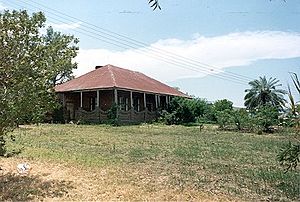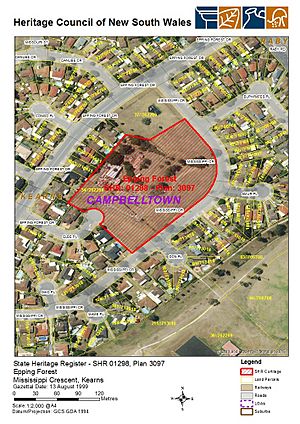Epping Forest, Kearns facts for kids
Quick facts for kids Epping Forest |
|
|---|---|
 |
|
| Location | Mississippi Crescent, Kearns, City of Campbelltown, New South Wales, Australia |
| Built | 1825– |
| Owner | Frank |
| Official name: Epping Forest | |
| Type | State heritage (complex / group) |
| Designated | 13 August 1999 |
| Reference no. | 1298 |
| Type | Homestead Complex |
| Category | Farming and Grazing |
| Builders | Unknown |
| Lua error in Module:Location_map at line 420: attempt to index field 'wikibase' (a nil value). | |
Epping Forest is a very old farm and house located in Kearns, New South Wales, Australia. It was built starting in 1825. Today, the building is empty, but it is still privately owned. This special place was added to the New South Wales State Heritage Register on August 13, 1999. This means it is protected because of its important history.
Contents
History of Epping Forest
The Airds Area
The whole area around Campbelltown used to be called Airds. In 1810, Governor Macquarie visited the area. He decided to create a new district there. He named it Airds to honor his wife's family estate in Scotland.
At first, the name Airds was used a lot. But as new towns grew, the name was used less often. It was brought back in 1975. That's when a new housing area was built and named Airds.
The Kearns Family and Epping Forest
The land where Epping Forest stands was part of the Minto district. In 1810, Governor Macquarie officially gave the land to Matthew and John Kearns. They each received about 40 hectares (100 acres) of land.
The rules for these land grants were strict. The Kearns brothers had to farm at least 10 hectares (25 acres) of their land. They were also allowed to cut timber from Crown land nearby. We don't know exactly where they farmed or cut timber. Matthew Kearns' land was called River Hill. It was part of a busy area near the new settlement of Campbelltown.
By the early 1820s, the land belonged to William Kearns. Records show he lived there in 1823. The main house at Epping Forest was built soon after, in 1825. The farm grew to include orchards, grain crops, and dairy farming. Some of the older sheds might have been built in the 1820s. However, most of the farm buildings were added later.
The Kearns family owned the property until 1960. Many family members lived there over the years. It was always used as a working farm. After 1912, the farm also raised special Ayreshire cattle. They even had a private racehorse stud. In the 1960s, they added mixed herd dairying.
What Epping Forest Looks Like
Epping Forest is built in the Old Colonial Georgian style. This was a popular building style in early Australia. The house is made from special sandstock bricks. It has a balanced look, meaning both sides of the front are the same. The roof is not too steep, and the edges are closed.
The front porch, called a verandah, is under the main roof. It has pretty wooden decorations. The thin wooden posts were shortened later. Brick railings were added to the verandah. The windows have small glass panes. The front door has a curved window above it, called a fanlight. This fanlight has very thin glass bars. The house also has stone windowsills and a stone floor on the verandah. At the back, there's a newer part made of timber and fibro.
Inside, the walls are plastered. There are also marble fireplaces. Many original parts of the house are still there. This includes the old wooden doors and frames.
There are also many sheds on the property. Two sheds are made of steel frames with corrugated iron. One large shed is made of rough timber with corrugated iron. There are also smaller timber sheds. Some of these smaller sheds have timber slab walls.
Condition of the Property
In 1999, the building was in fair condition. Many original parts of the house still exist. However, the building itself was not in great shape. The site also has a high chance of having old things buried there. This is called high archaeological potential.
Changes Over Time
- 1810: Land was given to the Kearns brothers.
- Around 1823: William Kearns brought the land together.
- Around 1825: The main house was built.
Why Epping Forest is Special
Epping Forest is important because it's a rare example of an early farm. It shows how farms were set up in the 1820s. The main house and other buildings are still there. They are located on a small hill. The land around the farm is still open. This helps us understand how the farm looked and worked long ago.
The house and other buildings show how they changed over time. New parts were added, and technology improved. This shows how the place was used as both a home and a farm. The way the farm is laid out, including the open land, helps us see how colonial buildings fit into the landscape. This is special in an area that is now very modern.
Epping Forest was added to the New South Wales State Heritage Register in 1999. It met several important reasons:
- It shows the history of New South Wales.
The house was built around 1825 in the Old Colonial Georgian style. The site has many clues about how people lived there. This includes gardens, fences, and sheds. It shows how the building was used as a home and farm for 140 years.
- It shows great design and skill.
The verandah being under the main roof is unusual for colonial houses. Most verandahs were built separately. This makes Epping Forest a unique example of design.
- It has a strong connection to a community.
Until recently, the same family owned and lived in the house. They were descendants of the first people who built it. This shows a long family connection to the land.
- It can teach us about history.
The dairy buildings date back to the 1820s. They show how dairy farming was done a long time ago. Changes made in the 1920s show how dairy and building technology improved.


